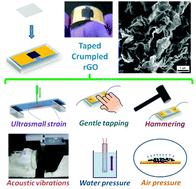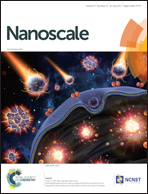Crumpled sheets of reduced graphene oxide as a highly sensitive, robust and versatile strain/pressure sensor†
Abstract
Sensing of mechanical stimuli forms an important communication pathway between humans/environment and machines. The progress in such sensing technology has possible impacts on the functioning of automated systems, human machine interfacing, health-care monitoring, prosthetics and safety systems. The challenges in this field range from attaining high sensitivity to extreme robustness. In this article, sensing of complex mechanical stimuli with a patch of taped crumpled reduced graphene oxide (rGO) has been reported which can typically be assembled under household conditions. The ability of this sensor to detect a wide variety of pressures and strains in conventional day-to-day applications has been demonstrated. An extremely high gauge factor (∼103) at ultralow strains (∼10−4) with fast response times (<20.4 ms) could be achieved with such sensors. Pressure resulting from a gentle touch to over human body weight could be sensed successfully. The capability of the sensor to respond in a variety of environments could be exploited in the detection of water and air pressures both below and above atmospheric, with a single device.



 Please wait while we load your content...
Please wait while we load your content...